Ag/Mo Doping for Enhanced Photocatalytic Activity of Titanium (IV) Dioxide during Fuel Desulphurization
Abstract
1. Introduction
2. Results and Discussion
2.1. Characterization
2.1.1. Field Emission Scanning Electron Microscopy (FESEM) and Particle Size
2.1.2. Atomic Force Microscopy
2.1.3. Energy-Dispersive X-ray Spectroscopy (EDS)
2.1.4. X-ray Diffraction Analysis
2.1.5. Fourier Transform Infrared (FTIR) Spectroscopy
2.1.6. Optical Properties
2.1.7. Photoluminescence (PL)
2.2. Photodesulphurization
3. Experiments
The Sol–Gel Method
4. Conclusions
Author Contributions
Funding
Institutional Review Board Statement
Informed Consent Statement
Data Availability Statement
Conflicts of Interest
References
- Zhou, X.; Wang, T.; Liu, H.; Gao, X.; Wang, C.; Wang, G. Desulfurization through Photocatalytic Oxidation: A Critical Review. ChemSusChem 2021, 14, 492–511. [Google Scholar] [CrossRef] [PubMed]
- Belousov, A.S.; Shafiq, I. Towards the Sustainable Production of Ultra-Low-Sulfur Fuels through Photocatalytic Oxidation. Catalysts 2022, 12, 1036. [Google Scholar] [CrossRef]
- Beshtar, M.; Larimi, A.; Asgharinezhad, A.A.; Khorasheh, F. Ultra-deep Photocatalytic Oxidative Desulfurization of Model Fuel Using Ti-UiO-66(Zr) Metal–Organic Framework. Catal. Lett. 2024, 154, 2633–2647. [Google Scholar] [CrossRef]
- Zbuzant, M. An Overview of the Use of Photo Catalysts for Desulfurization. Eurasian J. Chem. Med. Pet. Res. 2022, 1, 10–19. [Google Scholar] [CrossRef]
- Anucha, C.B.; Altin, I.; Bacaksiz, E.; Stathopoulos, V.N. Titanium dioxide (TiO2)-based photocatalyst materials activity enhancement for contaminants of emerging concern (CECs) degradation: In the light of modification strategies. Chem. Eng. J. Adv. 2022, 10, 100262. [Google Scholar] [CrossRef]
- Zarrabi, M.; Entezari, M.H. Modification of C/TiO2@MCM-41 with nickel nanoparticles for photocatalytic desulfurization enhancement of a diesel fuel model under visible light. J. Colloid Interface Sci. 2015, 457, 353–359. [Google Scholar] [CrossRef]
- Zaid, H.F.M.; Chong, F.K.; Mutalib, M.I.A. Mohamed Ibrahim Abdul Mutalib, Photooxidative–extractive deep desulfurization of diesel using Cu–Fe/TiO2 and eutectic ionic liquid. Fuel 2015, 156, 54–62. [Google Scholar] [CrossRef]
- Ostovar, A.; Larimi, A.; Jiang, Z.; Lotfi, M.; Ghotbi, C.; Khorasheh, F. Enhanced visible-light photocatalytic oxidative desulfurization of model fuel over Pt-decorated carbon-doped TiO2 nanoparticles. Environ. Sci. Pollut. Res. 2024, 31, 18188–18199. [Google Scholar] [CrossRef]
- Bazyari, A.; Khodadadi, A.A.; Mamaghani, A.H.; Beheshtian, J.; Thompson, L.T.; Mortazavi, Y. Microporous titania–silica nanocomposite catalyst-adsorbent for ultra-deep oxidative desulfurization. Appl. Catal. B Environ. 2016, 180, 65–77. [Google Scholar] [CrossRef]
- Fang, Z.; Xing, L.; Liu, Y.; Guo, X.; Qi, T.; Liu, J.; Wang, L. Ternary heterojunction stabilized photocatalyst of Co-TiO2/g-C3N4 in boosting sulfite oxidation during wet desulfurization. Appl. Surf. Sci. 2021, 551, 149478. [Google Scholar] [CrossRef]
- Khan, N.; Sapi, A.; Arora, I.; Sagadevan, S.; Chandra, A.; Garg, S. Photocatalytic CO2 reduction using metal and nonmetal doped TiO2 and its mechanism. React. Kinet. Mech. Catal. 2024, 137, 629–655. [Google Scholar] [CrossRef]
- Piątkowska, A.; Janus, M.; Szymański, K.; Mozia, S. C-,N- and S-Doped TiO2 Photocatalysts: A Review. Catalysts 2021, 11, 144. [Google Scholar] [CrossRef]
- Chakhtouna, H.; Benzeid, H.; Zari, N.; Qaiss, A.E.; Bouhfid, R. Recent progress on Ag/TiO2 photocatalysts: Photocatalytic and bactericidal behaviors. Environ. Sci. Pollut. Res. 2021, 28, 44638–44666. [Google Scholar] [CrossRef] [PubMed]
- Kumaravel, V.; Rhatigan, S.; Mathew, S.; Michel, M.C.; Bartlett, J.; Nolan, M.; Hinder, S.J.; Gascó, A.; Ruiz-Palomar, C.; Hermosilla, D.; et al. Mo doped TiO2: Impact on oxygen vacancies, anatase phase stability and photocatalytic activity. J. Phys. Mater. 2020, 3, 025008. [Google Scholar] [CrossRef]
- Hitam, C.N.C.; Jalil, A.A.; Abdulrasheed, A.A. A review on recent progression of photocatalytic desulphurization study over decorated photocatalysts. J. Ind. Eng. Chem. 2019, 74, 172–186. [Google Scholar] [CrossRef]
- Mahdi, B.R.; Meship Mahdi, A. Synthesis of Nano-TiO2 Thin Films by Sol-gel Dip-coating Method. Eng. Technol. J. 2015, 33 Pt B, 1303–1312. [Google Scholar] [CrossRef]
- Navas, D.; Fuentes, S.; Castro-Alvarez, A.; Chavez-Angel, E. Review on Sol-Gel Synthesis of Perovskite and Oxide Nanomaterials. Gels 2021, 7, 275. [Google Scholar] [CrossRef]
- Gupta, A.K.; Srivastava, P.; Bahadur, L. Improved performance of Ag-doped TiO2 synthesized by modified sol–gel method as photoanode of dye-sensitized solar cell. Appl. Phys. A 2016, 122, 724. [Google Scholar] [CrossRef]
- Chen, A.; Chen, W.-F.; Majidi, T.; Pudadera, B.; Atanacio, A.; Manohar, M.; Sheppard, L.R.; Liu, R.; Sorrell, C.C.; Koshy, P. Mo-doped, Cr-Doped, and Mo–Cr co-doped TiO2 thin-film photocatalysts by comparative sol-gel spin coating and ion implantation. Int. J. Hydrogen Energy 2021, 46, 12961–12980. [Google Scholar] [CrossRef]
- Simon, S.M.; Chandran, A.; George, G.; Sajna, M.S.; Valparambil, P.; Kumi-Barmiah, E.; Jose, G.; Biju, P.R.; Joseph, C.; Unnikrishnan, N.V. Development of Thick Superhydrophilic TiO2–ZrO2 Transparent Coatings Realized through the Inclusion of Poly(methyl methacrylate) and Pluronic-F127. ACS Omega 2018, 3, 14924–14932. [Google Scholar] [CrossRef]
- Liu, R. Ideal Site Geometry for Heterogeneous Catalytic Reactions: A DFT Study. Catalysts 2024, 14, 34. [Google Scholar] [CrossRef]
- Chin, S.; Park, E.; Kim, M.; Jeong, J.; Bae, G.-N.; Jurng, J. Preparation of TiO2 ultrafine nanopowder with large surface area and its photocatalytic activity for gaseous nitrogen oxides. Powder Technol. 2011, 206, 306–311. [Google Scholar] [CrossRef]
- Salman Hamdi, S. Synthesis of Ag–TiO2 Thin Films by Spin Coating process. Eng. Technol. J. 2016, 34 Pt A, 2443–2449. [Google Scholar] [CrossRef]
- Sada, M.S.; Jasimb, R.I.; Saleha, A.M.; Husseind, K.N.; Habubie, N.F.; Chiadb, S.S. Physical and sensing characterization of nanostructured Ag doped TiO2 thin films. J. Ovonic Res. 2024, 20, 255–265. [Google Scholar] [CrossRef]
- Sharma, H.; Singhal, R.; Siva Kumar, V.V.; Asokan, K. Structural, optical and electronic properties of Ag–TiO2 nanocomposite thin film. Appl. Phys. A 2016, 122, 1010. [Google Scholar] [CrossRef]
- National Institute of Standards and Technology (NIST). NIST Chemistry WebBook; SRD 69, COBLENTZ No. 4649; NIST: Gaithersburg, MD, USA, 1970. [Google Scholar]
- Weichman, M.L.; Song, X.; Fagiani, M.R.; Debnath, S.; Gewinner, S.; Schöllkopf, W.; Neumark, D.M.; Asmis, K.R. Gas phase vibrational spectroscopy of cold (TiO2)−n (n = 3–8) clusters. J. Chem. Phys. 2016, 144, 124308. [Google Scholar] [CrossRef]
- Pohan, L.A.G.; Kambiré, O.; Nasir, M.; Ouattara, L. Photocatalytic and Antimicrobial Properties of [AgTiO2]:[Clay] Nanocomposite Prepared with Clay Different Ratios. Mod. Res. Catal. 2020, 9, 47–61. [Google Scholar] [CrossRef]
- Jayasawal, A.; Sharma, S.; Singh, S.; Srivastava, P. Extensive enhancement in power conversion efficiency of dye-sensitized solar cell by using Mo-doped TiO2 photoanode. J. Solid State Electrochem. 2022, 26, 2209–2217. [Google Scholar] [CrossRef]
- Wang, P.; Jiang, X.; Zhang, C.; Zhou, Q.; Li, J.; Jiang, W. Desulfurization and Regeneration Performance of Titanium-Ore-Modified Activated Coke. Energy Fuels 2017, 31, 5266–5274. [Google Scholar] [CrossRef]
- Sadkhan, A.K. Optical Characterizations of RF-Magnetron Sputtered Nanocrystalline TiO2 Thin Film. Eng. Technol. J. 2018, 36 Pt B, 156–159. [Google Scholar] [CrossRef]
- Makuła, P.; Pacia, M.; Macyk, W. How to Correctly Determine the Band Gap Energy of Modified Semiconductor Photocatalysts Based on UV–Vis Spectra. J. Phys. Chem. Lett. 2018, 9, 6814–6817. [Google Scholar] [CrossRef] [PubMed]
- Pitre, S.P.; Yoon, T.P.; Scaiano, J.C. Titanium dioxide visible light photocatalysis: Surface association enables photocatalysis with visible light irradiation. Chem. Commun. 2017, 53, 4335–4338. [Google Scholar] [CrossRef]
- Nigussie, G.Y.; Tesfamariam, G.M.; Tegegne, B.M.; Weldemichel, Y.A.; Gebreab, T.W.; Gebrehiwot, D.G.; Gebremichel, G.E. Antibacterial Activity of Ag-Doped TiO2 and Ag-Doped ZnO Nanoparticles. Int. J. Photoenergy 2018, 2018, 5927485. [Google Scholar] [CrossRef]
- Li, X.; Li, J.; Zhai, H.; Song, M.; Wang, L.; Guan, R.; Zhang, Q.; Zhao, Z. Efficient Catalytic Fixation Nitrogen Activity under Visible Light by Molybdenum Doped Mesoporous TiO2. Catal. Lett. 2022, 152, 116–123. [Google Scholar] [CrossRef]
- Zhou, J.; Feng, B.; Lu, X.; Duan, K. Novel one-step fabrication of highly ordered Mo-doped TiO2 nanotubes arrays with enhanced visible light catalytic activity. J. Mater. Sci. Mater. Electron. 2018, 29, 18388–18396. [Google Scholar] [CrossRef]
- Khlyustova, A.; Sirotkin, N.; Kusova, T.; Kraev, A.; Titov, V.; Agafonov, A. Doped TiO2: The effect of doping elements on photocatalytic activity. Mater. Adv. 2020, 1, 1193–1201. [Google Scholar] [CrossRef]
- Huang, L.; He, G.; Yuan, Y.; Zhang, T.C.; Wang, Y.; Yuan, S. Trivalent Metal Ions (Al, Ga, In)-Doped TiO2 for Enhanced Photocatalytic Desulfurization of H2S: Band Structure Regulation, Performance, and Mechanism. Ind. Eng. Chem. Res. 2024, 63, 7154–7165. [Google Scholar] [CrossRef]
- Li, X.; Zhu, Z.; Li, F.; Huang, Y.; Hu, X.; Huang, H.; Peng, R.; Zhai, X.; Fu, Z.; Lu, Y. Multifunctional Single-Phase Photocatalysts: Extended Near Infrared Photoactivity and Reliable Magnetic Recyclability. Sci. Rep. 2015, 5, 15511. [Google Scholar] [CrossRef]
- Mancuso, A.; Navarra, W.; Sacco, O.; Pragliola, S.; Vaiano, V.; Venditto, V. Photocatalytic Degradation of Thiacloprid Using Tri-Doped TiO2 Photocatalysts: A Preliminary Comparative Study. Catalysts 2021, 11, 927. [Google Scholar] [CrossRef]
- Nanaji, K.; Janardhana, R.K.S.K.; Rao, T.N.; Anandan, S. Energy level matching for efficient charge transfer in Ag doped—Ag modified TiO2 for enhanced visible light photocatalytic activity. J. Alloys Compd. 2019, 794, 662–671. [Google Scholar] [CrossRef]
- Feng, N.; Liu, F.; Huang, M.; Zheng, A.; Wang, Q.; Chen, T.; Cao, G.; Xu, J.; Fan, J.; Deng, F. Unravelling the Efficient Photocatalytic Activity of Boron-induced Ti3+ Species in the Surface Layer of TiO2. Sci. Rep. 2016, 6, 34765. [Google Scholar] [CrossRef] [PubMed]
- Zhang, Y.; Liu, C.; Liu, X.; Wei, Z.; Tao, H.; Xu, F.; Wang, L.; Pan, J.; Lei, W.; Chen, J. Localized Surface Plasmon-Enhanced Infrared-to-Visible Upconversion Devices Induced by Ag Nanoparticles. Materials 2023, 16, 1973. [Google Scholar] [CrossRef] [PubMed]
- Selvi, K.T.; Sagadevan, S. Recent developments in optoelectronic and photonic applications of metal oxides. In Metal Oxides for Optoelectronics and Optics-Based Medical Applications; Sagadevan, S., Podder, J., Mohammad, F., Eds.; Elsevier: Amsterdam, The Netherlands, 2022; pp. 33–57. [Google Scholar] [CrossRef]
- Carp, O.; Huisman, C.L.; Reller, A. Photoinduced reactivity of titanium dioxide. Prog. Solid State Chem. 2004, 32, 33–177. [Google Scholar] [CrossRef]
- Xie, S.; Zhao, X.; Wang, D.; Yang, H.; Yang, L.; Bai, L.; Wei, D.; Wang, W.; Liang, Y.; Chen, H.; et al. MoOx nanoclusters on Mo-doped TiO2 nanosheets with enhanced singlet oxygen generation and sulfide conversion abilities for photocatalytic aerobic oxidative desulfurization. Sci. China Chem. 2024, 67, 408–414. [Google Scholar] [CrossRef]
- Mohtar, S.S.; Aziz, F.; Ismail, A.F.; Sambudi, N.S.; Abdullah, H.; Rosli, A.N.; Ohtani, B. Impact of Doping and Additive Applications on Photocatalyst Textural Properties in Removing Organic Pollutants: A Review. Catalysts 2021, 11, 1160. [Google Scholar] [CrossRef]
- Wang, G.; Lv, S.; Shen, Y.; Li, W.; Lin, L.; Li, Z. Advancements in heterojunction, cocatalyst, defect and morphology engineering of semiconductor oxide photocatalysts. J. Mater. 2024, 10, 315–338. [Google Scholar] [CrossRef]
- Dedual, G.; MacDonald, M.J.; Alshareef, A.; Wu, Z.; Tsang, D.C.; Yip, A.C. Requirements for effective photocatalytic oxidative desulfurization of a thiophene-containing solution using TiO2. J. Environ. Chem. Eng. 2014, 2, 1947–1955. [Google Scholar] [CrossRef]
- Cao, Y.; Wang, H.; Ding, R.; Wang, L.; Liu, Z.; Lv, B. Highly efficient oxidative desulfurization of dibenzothiophene using Ni modified MoO3 catalyst. Appl. Catal. A Gen. 2020, 589, 117308. [Google Scholar] [CrossRef]
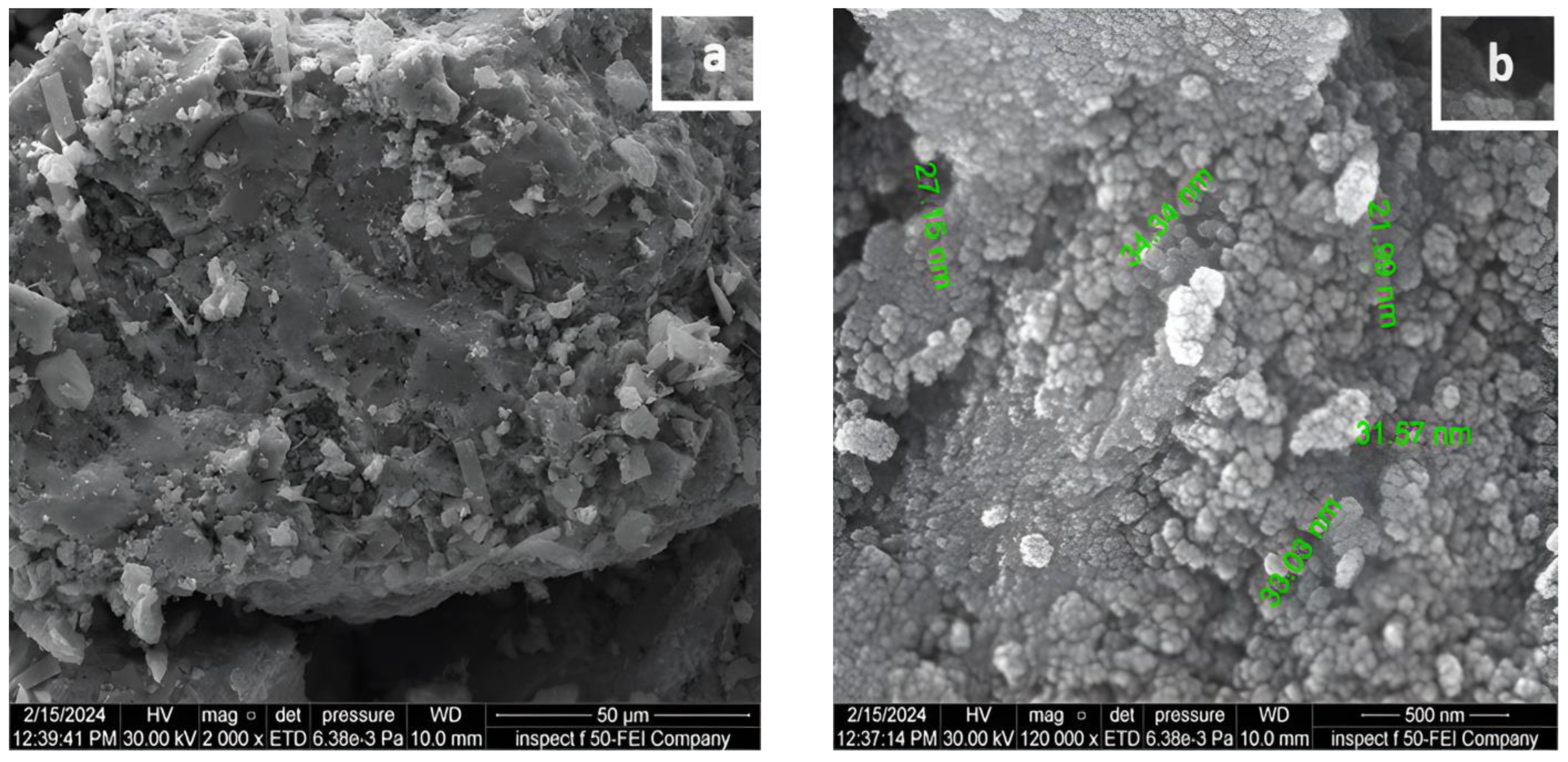
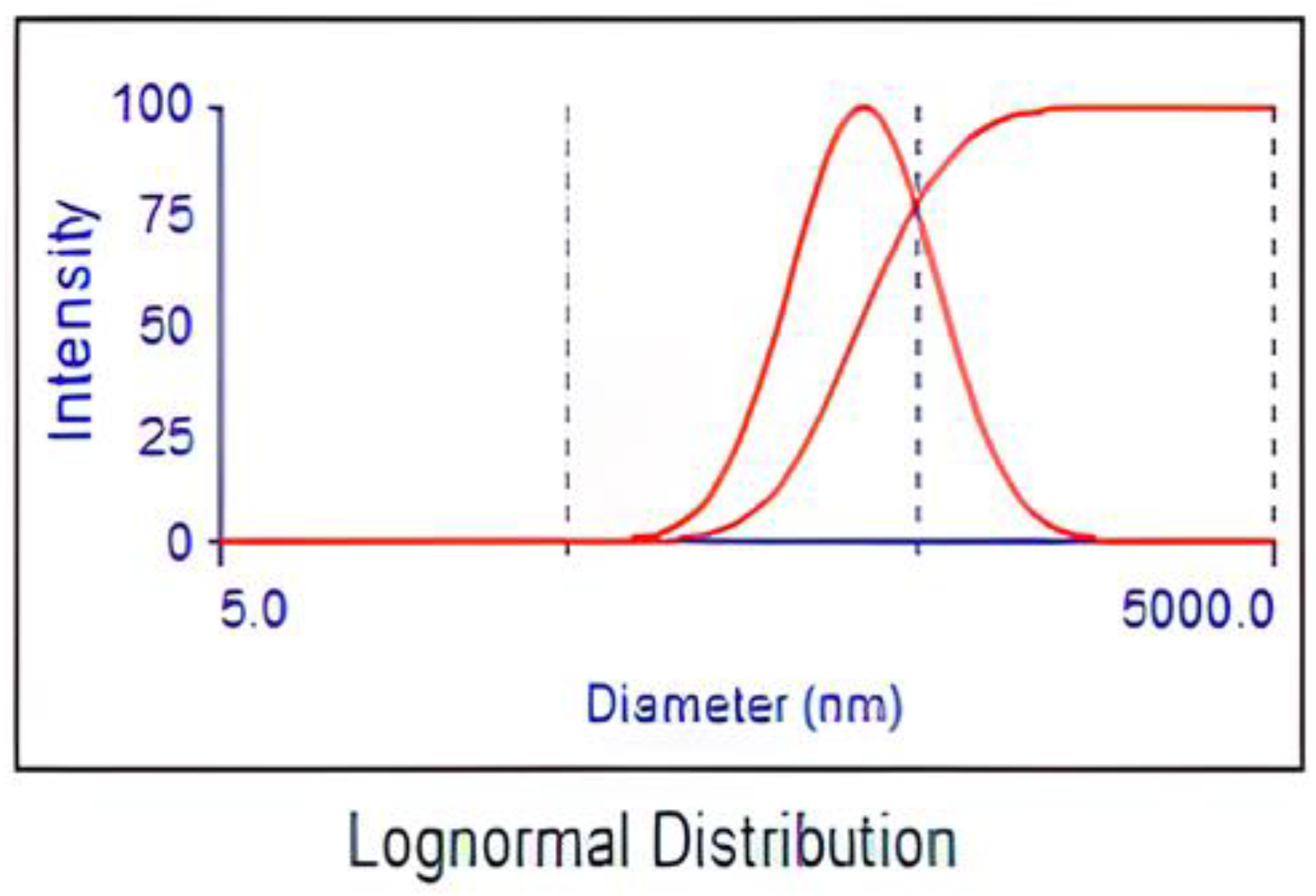
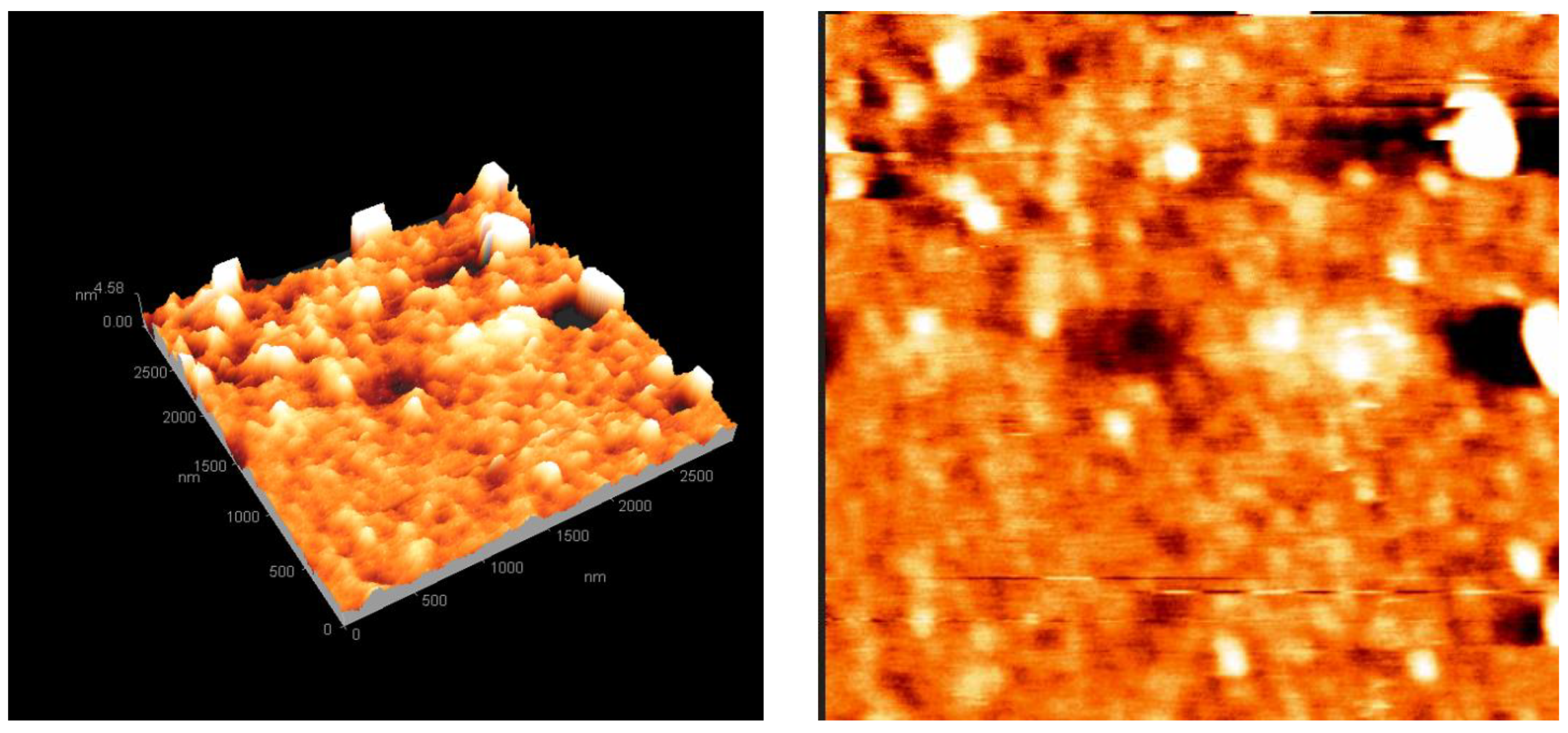
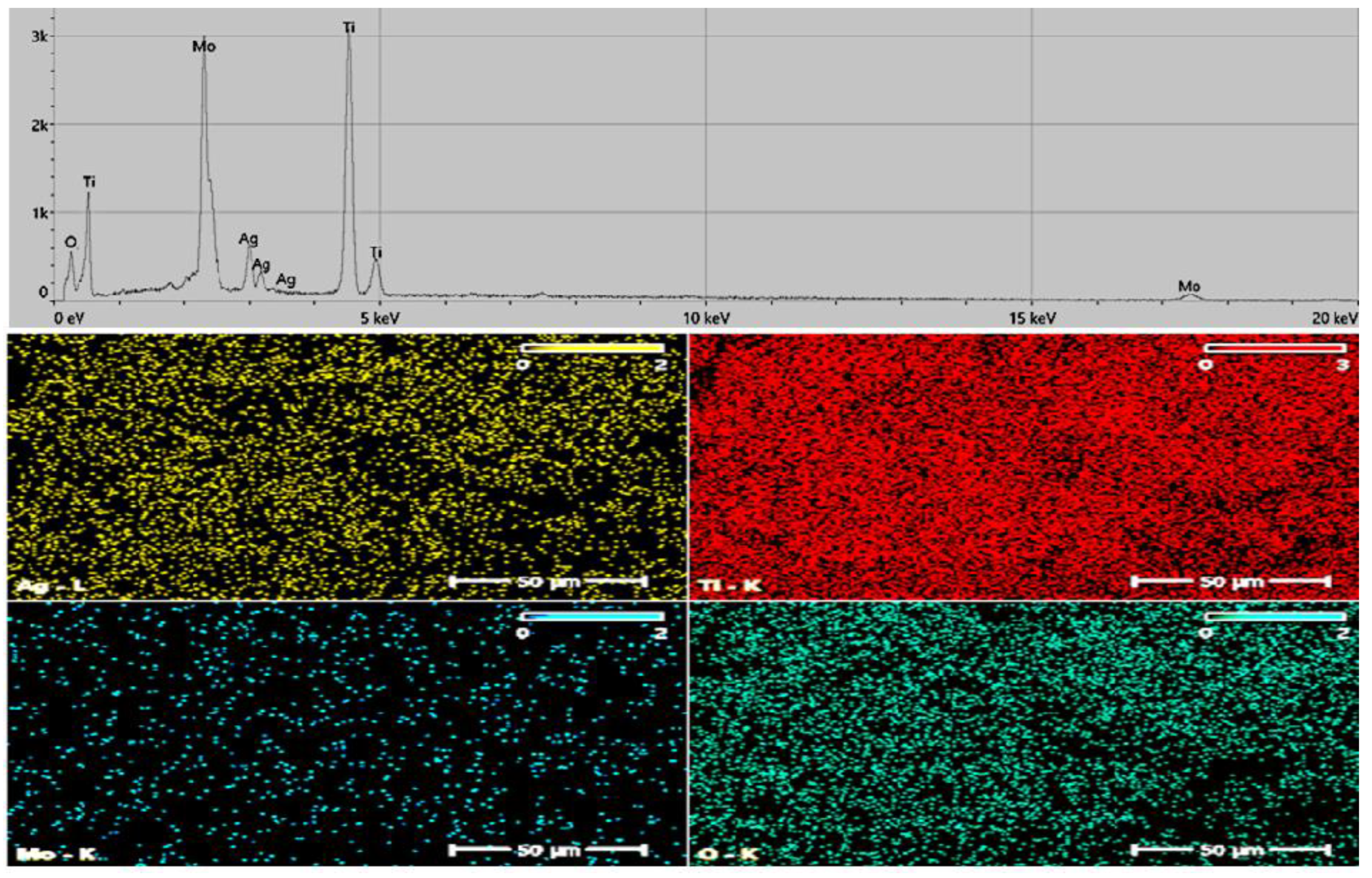

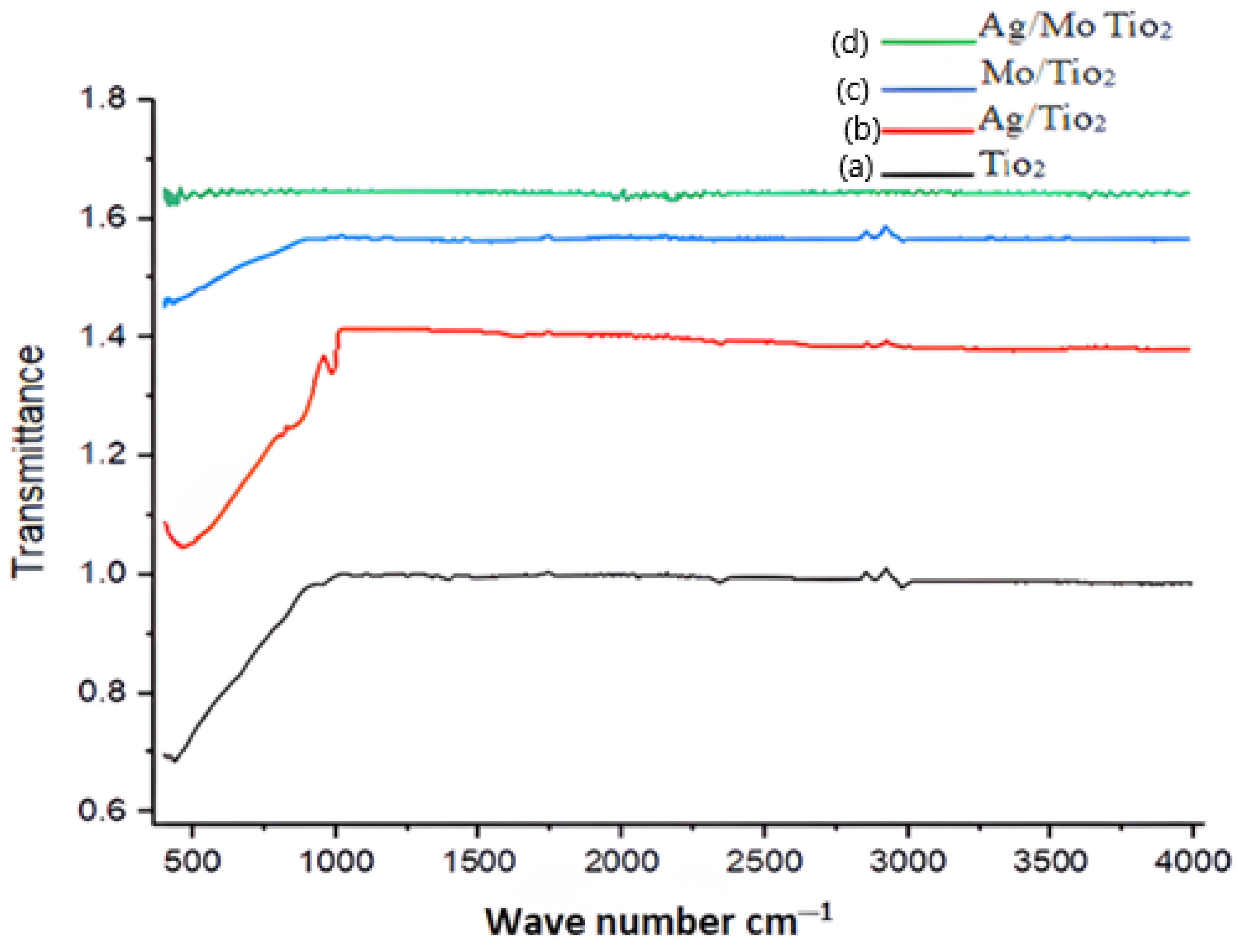
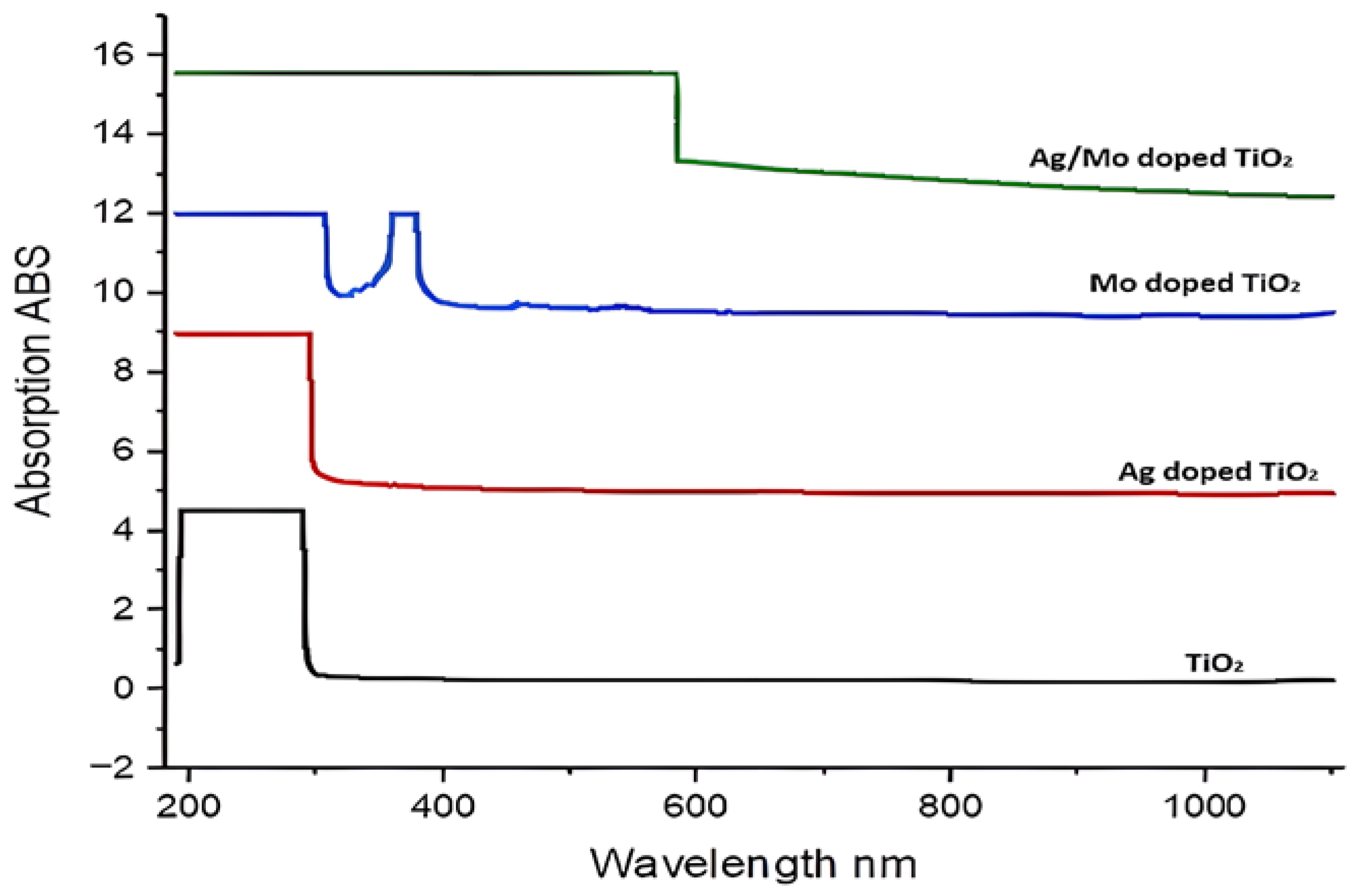
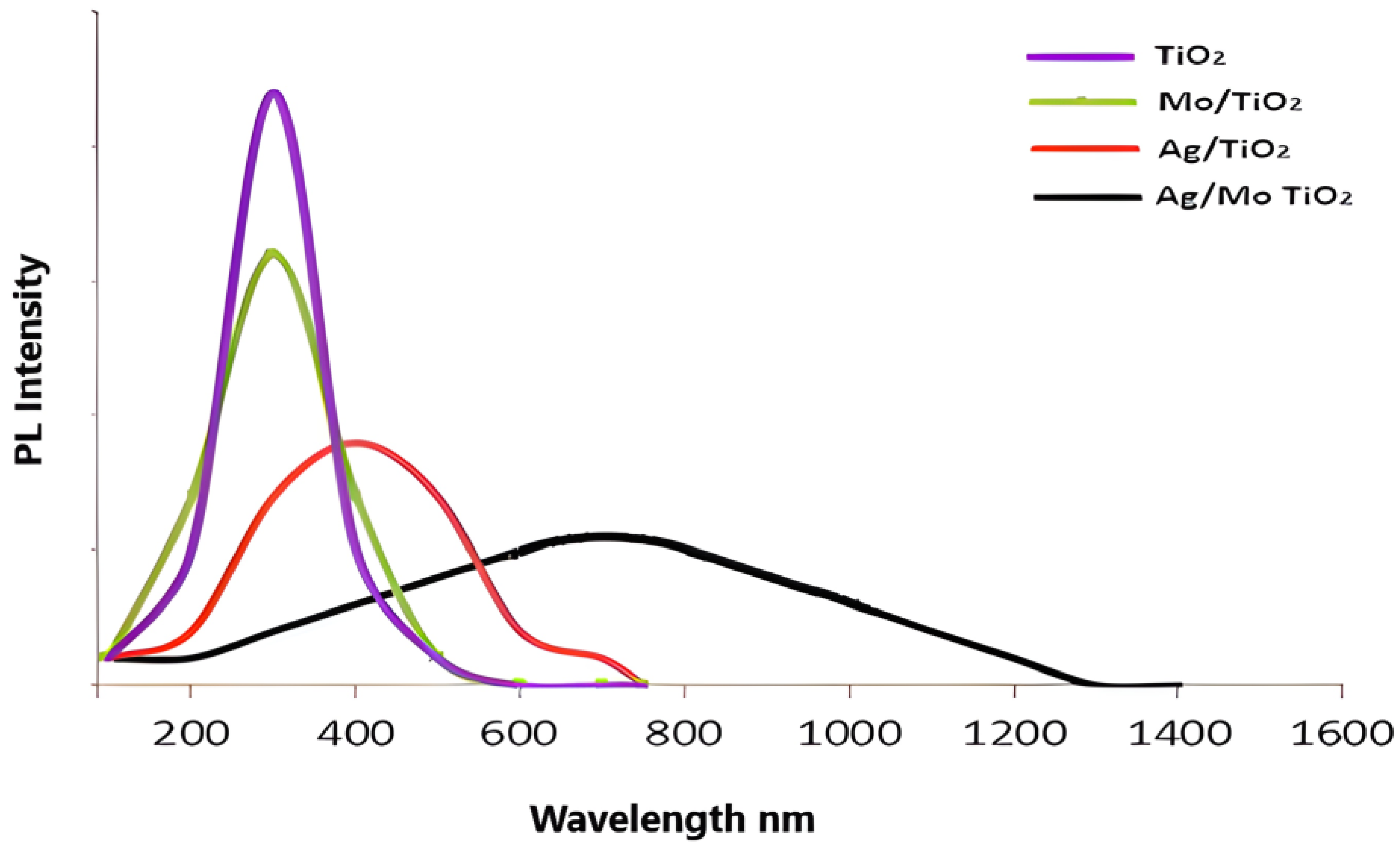
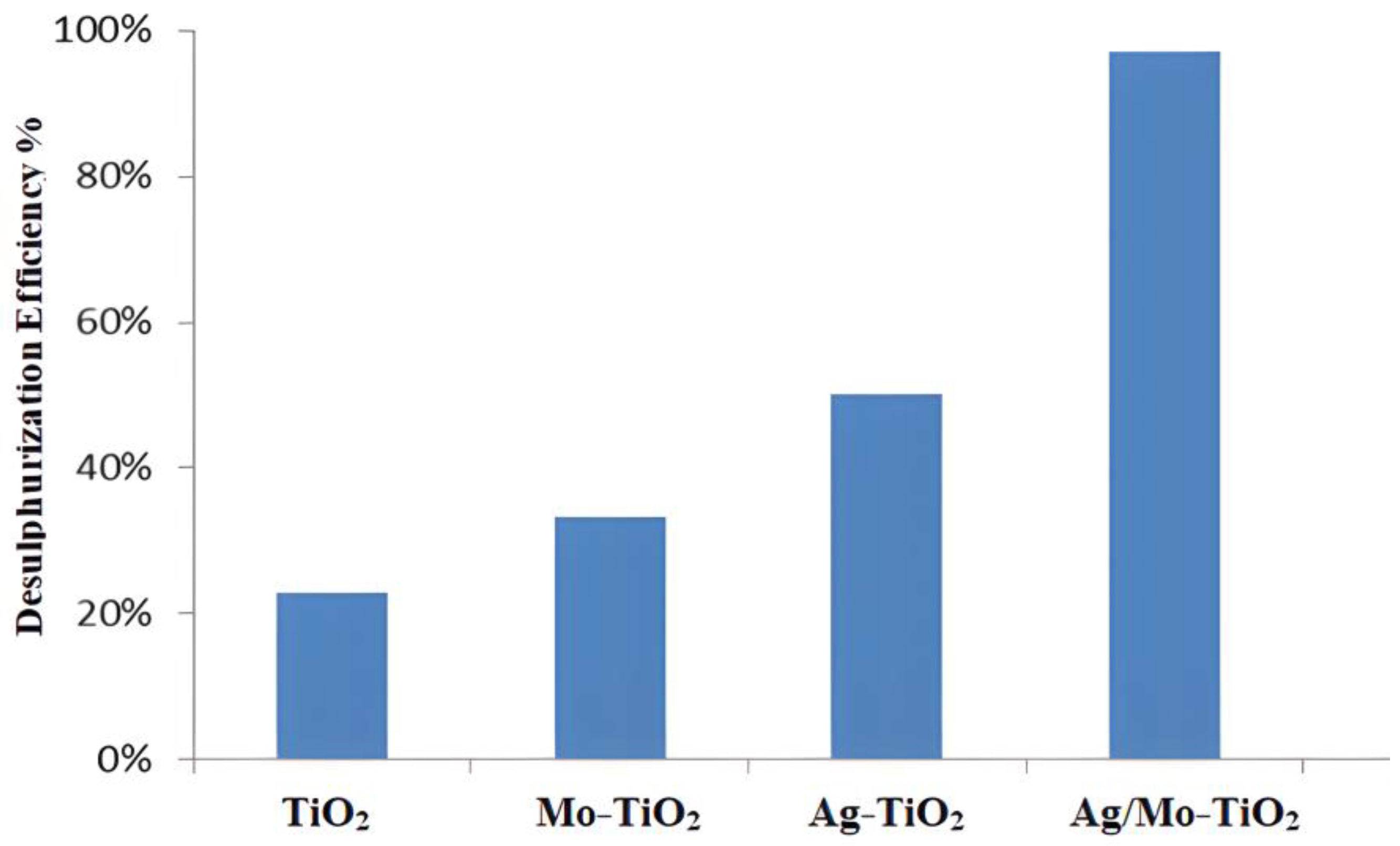

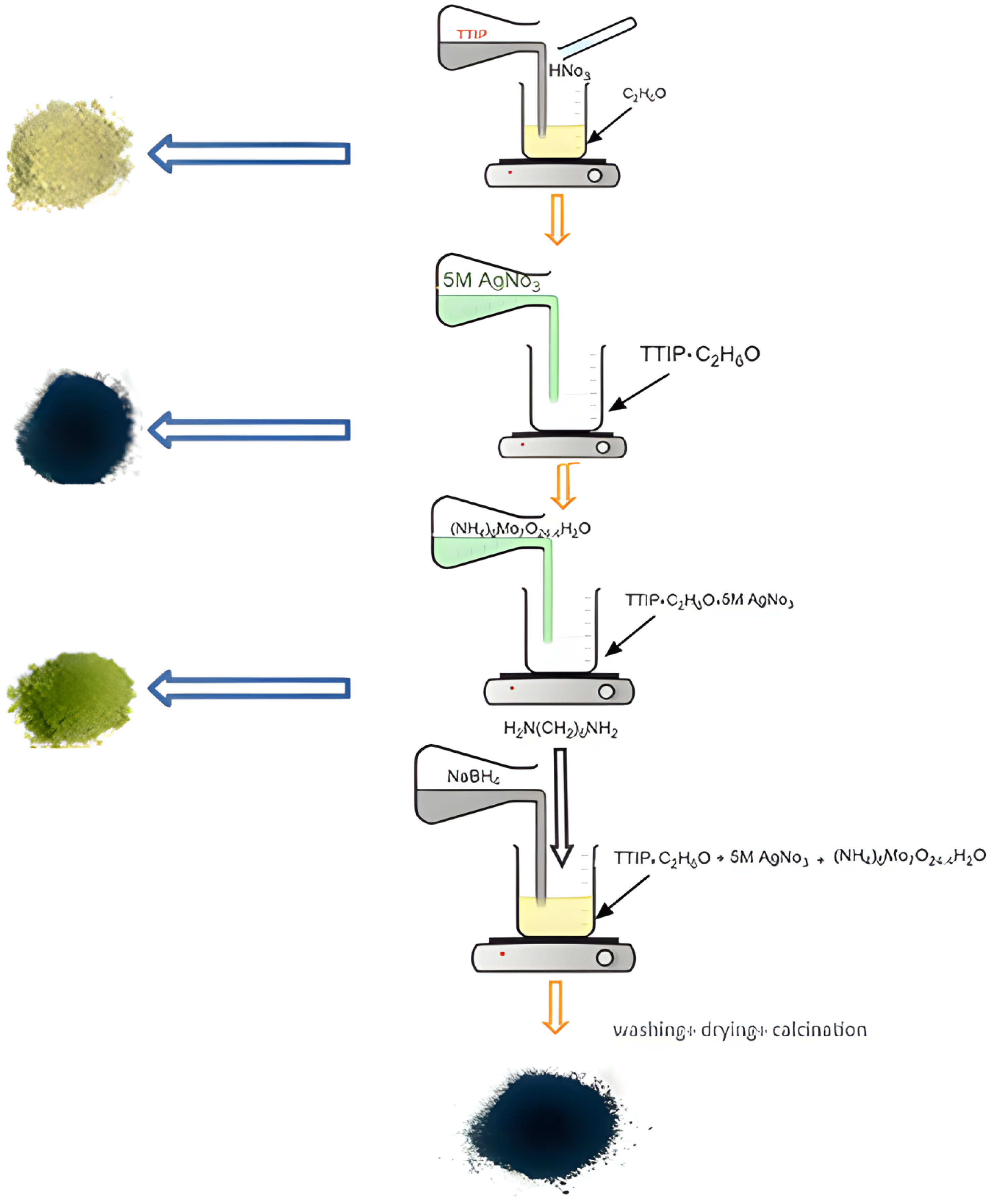
| Energy band gap (e.v) | TiO2 | Ag-Doped TiO2 | Mo-Doped TiO2 | Ag/Mo-Doped TiO2 |
| 3.54 | 1.23 | 2.7 | 1.18 |
| Light Distillate | Value |
|---|---|
| Specific gravity at 60 °C | 0.733 |
| Flash point | 64 |
| Viscosity | 0.97 |
| Sulphur content | 892.5 ppm |
Disclaimer/Publisher’s Note: The statements, opinions and data contained in all publications are solely those of the individual author(s) and contributor(s) and not of MDPI and/or the editor(s). MDPI and/or the editor(s) disclaim responsibility for any injury to people or property resulting from any ideas, methods, instructions or products referred to in the content. |
© 2024 by the authors. Licensee MDPI, Basel, Switzerland. This article is an open access article distributed under the terms and conditions of the Creative Commons Attribution (CC BY) license (https://creativecommons.org/licenses/by/4.0/).
Share and Cite
Hamza, Z.A.; Dawood, J.J.; Jabbar, M.A. Ag/Mo Doping for Enhanced Photocatalytic Activity of Titanium (IV) Dioxide during Fuel Desulphurization. Molecules 2024, 29, 4603. https://doi.org/10.3390/molecules29194603
Hamza ZA, Dawood JJ, Jabbar MA. Ag/Mo Doping for Enhanced Photocatalytic Activity of Titanium (IV) Dioxide during Fuel Desulphurization. Molecules. 2024; 29(19):4603. https://doi.org/10.3390/molecules29194603
Chicago/Turabian StyleHamza, Zahraa A., Jamal J. Dawood, and Murtadha Abbas Jabbar. 2024. "Ag/Mo Doping for Enhanced Photocatalytic Activity of Titanium (IV) Dioxide during Fuel Desulphurization" Molecules 29, no. 19: 4603. https://doi.org/10.3390/molecules29194603
APA StyleHamza, Z. A., Dawood, J. J., & Jabbar, M. A. (2024). Ag/Mo Doping for Enhanced Photocatalytic Activity of Titanium (IV) Dioxide during Fuel Desulphurization. Molecules, 29(19), 4603. https://doi.org/10.3390/molecules29194603






